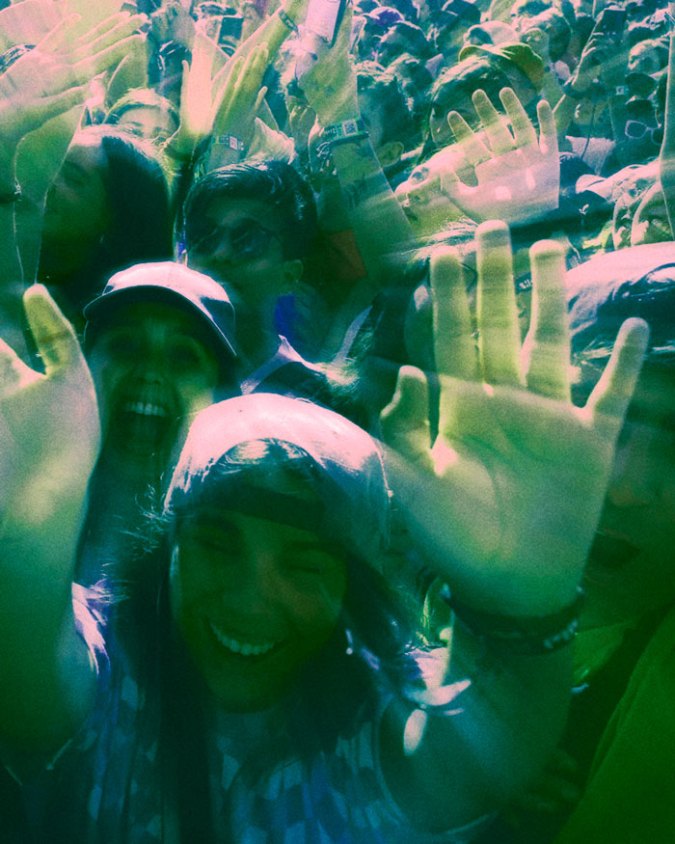The days of showering artists with flowers (or Dr. Simi Plushies) during their performances are becoming a thing of the past. Nowadays, fans are throwing more attention-grabbing, albeit riskier, objects onto the stage — an unsettling trend that is gaining popularity and posing a growing danger.
Among the long list of items being thrown at artists as of late — vapes, a bag of human ashes (yes, ashes), and books — was a cell phone thrown at Rauw Alejandro’s head during his Saturno World Tour stop in Boston, MA. After getting struck, he told the audience: “From the bottom of my heart and with all due respect, I would like to ask you to be careful with what you are throwing on the stage.”
Rauw isn’t the only one caught up in this peculiar trend. Over the past year, several other music artists, such as Latto, Harry Styles, Pink, Drake, and Bebe Rexha, have also faced items being hurled onto the stage during their performances.
This leads us to the burning question: Why is this happening?

There are several theories that attempt to explain the underlying motivation driving this behavior. One plausible explanation for this phenomenon is rooted in the complexities of parasocial relationships gone wrong. These one-sided relationships typically involve a scenario where one individual (i.e. celebrities, athletes) is completely unaware of the existence of the other who extends emotional energy, interest, and time into them (i.e. fans). Of course, parasocial relationships are not inherently negative; they can prove to be constructive or healthy. Particularly for teens, these relationships can play a pivotal role in helping them form an identity and develop autonomy from their parents, as stated in this 2017 study.
However, there’s a fine line. In a study done by psychologist Lynn McCutcheon, who co-developed the Celebrity Attitude Scale, three types of parasocial relationships are defined: entertainment-social, intense-personal, and borderline-pathological. The last two are as alarming as they sound, and they are characterized by obsession and compulsive behaviors — such as throwing an object at an artist. Furthermore, McCutcheon found that scores on the Celebrity Attitude Scale “increased dramatically” between 2001 and the present — especially within the past year or so.
Those intense-personal and borderline-pathological parasocial relationships are generally experienced by people with high levels of anxiety, which has been on the rise since the COVID-19 pandemic, according to psychiatric nurse practitioner and founder of ZenzyTalk Jake Hernandez.

“The baseline level of anxiety has just heightened over the last three years. A lot of people don’t interact face to face as often as they were before the pandemic, so there’s an increased need for closeness and approval from others,” says Hernandez.
For fans experiencing a toxic parasocial relationship, this can translate to a need for closeness and approval from their favorite celebrity. A person who throws their cell phone at an artist — such as in the case of the fan who threw a phone at Rauw Alejandro – might have the hope that the artist will take a photo with their phone and that it will make them feel close, even if just for a moment.
“There’s an increased need for closeness and approval from others”
On the other side of the coin, there are the fans that have what pop-culture calls, “main character syndrome.” Main character syndrome, simply put, is bulldozing through life with a lack of consideration for others and stealing the spotlight from those around you in the process.

“Main character syndrome is not really a psychological term, but it is defined by a need for external validation, a lack of self-confidence, a sense of entitlement, and a lack of empathy,” Hernandez says. “It’s a difficulty separating the needs of others from your own or seeing that the artist at a concert has their own boundaries and their own level of anxiety while performing a show,” he adds.

Tour managers are also noticing this phenomenon firsthand and its effect on artists. Clarissa Paez, a former tour manager and strategic marketing manager for artists such as Christian Nodal, Bizarrap, Nicki Nicole, and more, shared more on the anxieties that artists grapple with due to this trend.
“Sometimes fans think that the artist is not a human who can feel and be scared of being on stage. Due to social media, fans think that they have authority over the artists because artists have shown their personal life online,” she says. Adding that, “the adrenaline of being a fan and wanting to be in touch with their idol gets a little weird, and they act like that, throwing whatever is in their hand just to have a second of their idol’s attention.”

According to Paez, there is little that can be done by security to control these behaviors, given that most items thrown are permissible within venues, and the unpredictable nature of when such items might be launched further complicates the situation. Ultimately, the responsibility rests with the fans themselves. In the complex interplay between fans’ fervent displays of affection and their desire for validation, it becomes evident that the boundaries of adoration have blurred, leaving both performers and their admirers in uncharted territory.
Therein lies the true mystery of this phenomenon, which is not whether we are capable of stopping this behavior, but rather how.




